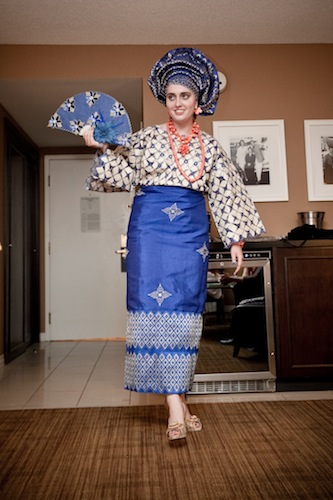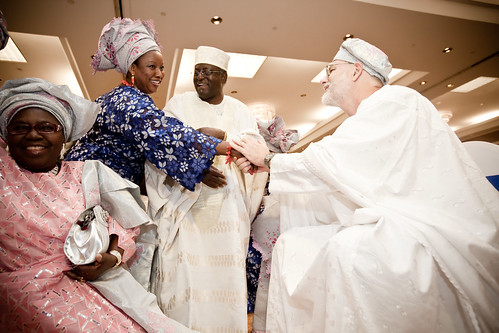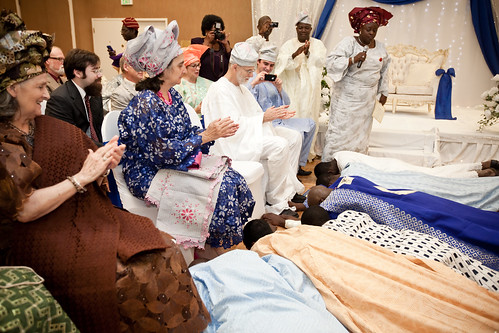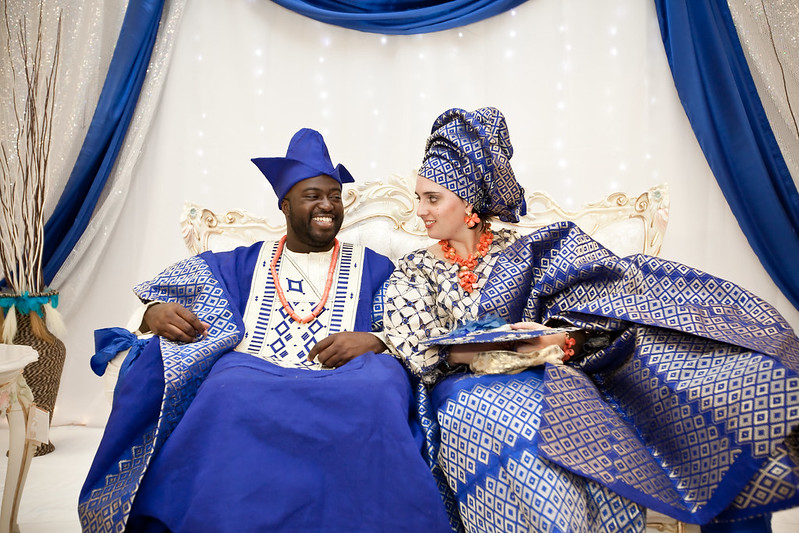I'm generally of the belief that your wedding is not always about you, but it should reflect you: your beliefs, your values, and your community. One of the comments that we heard most often about our wedding was: “It was so… you,” and I loved it, because that was one of our goals in planning the event. I think that is why I struggled so much with my feelings about the Nigerian engagement ceremony that we had the week before our wedding. The entire event was just so not me, not at all.

Allow me to explain with a summary of a Nigerian engagement ceremony…
(Disclaimer: This is my understanding after nine months of preparation, and one day of living through it, not as someone raised in the culture. It was a Christian, Yoruba ceremony.)
A Nigerian engagement ceremony is usually hosted by the wife's family and occurs shortly before the wedding. It is sometimes also referred to as the “Traditional Wedding.” (For our ceremony, my in-laws planned and hosted it and it was the weekend before our wedding.) The focus is on the families (including extended family and friends) meeting each other, joining to become one family, and formally giving their approval and blessings to the couple.

The ceremony starts with the bride's side in the ceremony venue and the groom's side petitioning to come in. There is money that exchanges hands and a lot of dancing, singing, and prayer (all of which continue throughout the rest of the ceremony). When the groom's side is allowed to enter, they greet the bride's side. Then everyone settles so that each side is sitting in chairs facing an aisle that leads to the dais where the couple will eventually sit.

The groom enters with his entourage of young men. They prostrate (lie flat on the ground) in front of his parents and ask for their blessing and prayers. His parents raise him up and he sits between them and hugs them. Then he goes to the bride's parents and does the same thing, except the master of ceremonies for the bride's family (the Alaga Ijoko) may require the men to prostrate multiple times or perform other tasks before they win approval. The bride enters, veiled, with an entourage of young women. She goes through a process similar to the groom's, except that she kneels instead of prostrating. Then she goes up to sit with the groom on the dais.

The dowry is brought in. The bride is called by the Alaga to look at the dowry and asked to choose a gift to open. After pretending indecision, she selects a bible, demonstrating that she values faith over material possessions. Inside the bible she finds her engagement ring. The groom is called down and puts the ring on her finger. Then he picks her up, carries her around to show off the ring and his strength, and carries her to their seat on the dais.

Finally the proposal letter from the groom's side and acceptance letter from the bride's side are read, either by the sisters of the couple or by Alaga if (as in my case) there is no sister. Everyone eats and the couple cuts their cake. Then everyone dances and celebrates late into the night.
So, how could I feel good about a ceremony where I didn't feel like myself and nothing else felt like me either?
In the end, it's really been a two-step process…
The first step was what I spent a lot of time doing both leading up to the ceremony and during the ceremony itself: focus on the positive things. First and foremost I focused on my husband-to-be and our relationship that I am so grateful for. I focused on how supportive and flexible my parents were being in all of this, and on how this was part of how his family showed their love. I focused on the importance of unifying our families, which is the central point of the ceremony. I researched to familiarize myself with the traditions around the ceremony, and was touched when my husband's family and friends were excited by my new knowledge. I reminded myself that even if the aesthetic wasn't one that I would have chosen, it was one I could appreciate, and it resulted in stunning pictures.
The second step is one I'm still working on. I have realized that the research, compromising, and negotiating that we went through for the engagement ceremony is just a sample of what will come. Now that we are married, our interactions with each other's families have become more complex, and the question of when we will have children has become the new focus of discussion. When we do (eventually) have kids, issues of race, culture, and compromise will become even more apparent and relevant. For now, I will try to adjust to the idea that I can't just think of our relationship as intercultural, I need to figure out a way to identify myself as intercultural as well.








